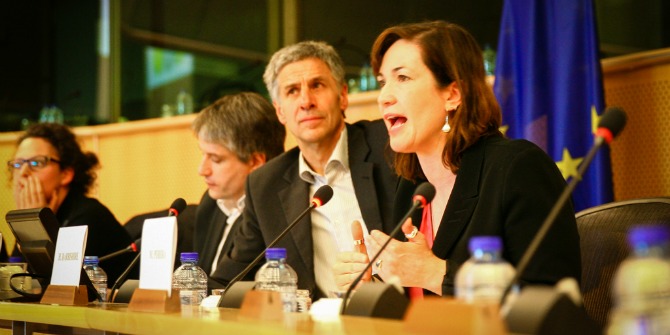Digital ‘liquid’ consumption is delimited from solid physical possession by ephemerality, dematerialisation, and accessibility. Web3 applications (including non-fungible tokens, the metaverse and decentralised platforms) have the potential to de-liquify consumption and re-attribute the notions of ownership, longevity, and materiality to digital goods. Daniel Albrecht Nuedling writes that Web3 technologies reshape the notion of digital ownership and offer access to disruptive ways for brands to foster consumer engagement and loyalty.
The early vision of the internet as a libertarian utopia, offering free access to information for all, was quickly overtaken by commercial interests. After initial failures of web monetisation had led to the dot-com bubble, Web 2.0 brought concentrated control of digital assets to a few incumbents, leaving users with limited rights and ownership but instead paying for the right to use the respective offerings owned by the platforms on a pay-per-use or subscription basis. Powered by blockchain technology, Web3 heralds the promise to revive this original ideal, offering decentralised applications and empowering users with content ownership and novel monetisation opportunities.
Web3 relies mainly on the decentralised ledger or blockchain technology with embedded, automatically executed smart contracts, creating trust-free (frictionless) environments for transactions across various sectors by making intermediaries like brokers, experts, banks, or lawyers obsolete. Non-fungible tokens (NFTs) represent a significant facet of Web3, offering unique digital assets that can encompass various manifestations of content in the offline and online worlds simultaneously. Stored on blockchain networks like Ethereum, NFTs enable fully individualised ownership by removing the otherwise cost- and time-free unlimited replication of digital assets and catalysing trading of these assets.
Web3 thus has the potential to revolutionise consumption by democratising digital transactions, catering to the needs of ever-changing individual circumstances and the transitory social landscape consumers are facing.
Liquid modernity
Emphasising instant access over ownership, liquid consumption characterises modern consumption behaviour. While digital liquid consumption is delimited from solid physical possession by its inherent virtues of ephemerality, dematerialisation and accessibility, Web3 applications have the potential to de-liquify the latter and re-attribute the notions of ownership, longevity, and materiality to digital goods, which have traditionally been attributed to material possession exclusively.
Gen Z, composed of so-called digital natives, values experiences and community building over material possessions. They prefer experiences over materialism, driving a shift towards unique, authentic, and shareable experiences – still leaving an unsatisfied demand for self-expression and community participation. The COVID-19 context has further expedited this generational preference but also increased prudence about in-person encounters and a shift towards virtual and hybrid experiences instead.
The use value becomes the pivotal momentum in customers’ decisions, where they seek experimental, intrinsic value catering to the individual self-worth bias and prefer utility to external demarcation like status signalling. We are what we have has turned into we are what we experience.
Four ways Web3 ‘de-liquefies’ digital assets
1. Individualisation: NFTs provide uniqueness and authenticity to digital items, mirroring the traditional notion of originality of physical items.
2. Physical-digital integration: Web3 blurs the lines between physical and digital realms, allowing digital items to be displayed in real-world settings and vice versa.
3. Democratisation: Web3 empowers users with control over their intellectual property and offers fractional ownership, making expensive assets accessible to new customer groups.
4. Community building: Ownership of NFTs grants access to exclusive communities and events, fostering brand loyalty.
The potential applications of Web3 in brand engagement are vast. Brands can use fractional ownership and sharing models to connect with consumers through different channels at low entry levels. Decentralised loyalty platforms employing gamification elements such as reward levels can enhance customer engagement. Vividly-changing trends in the technological sector, such as the rise and fall of the NFT art market, the digital land grab in the Metaverse or the recent, unprecedented ascent of ChatGPT, lead to the conclusion that we can’t foresee which technology will prevail on a large scale and scope in the long run.
Widespread adoption combined with a profound business application will be paramount, however this point has not been reached yet. Luxury goods brands have therefore taken manifold approaches, which has generated a significant amount of sunk costs and not too many financially viable outcomes so far. Technology adoption is at an experimental stage, where it is not possible to predict if those investments will ever pay off, while most market players cannot follow every emerging trend. Hence, I advocate for a unified approach.
Industry-wide collaborative approach
Representing the majority of the luxury goods industry, the Aura Blockchain Consortium, initiated by predominant groups Richemont, LVMH, Prada, Mercedes Benz and OTB, showcases the first industry-wide collaborative approach towards adopting Web3 for product authentication, sustainability-proof throughout the whole product life cycle, and innovation. As Web3 will lead to a partial loss of control of companies over their brand equity, Aura is an intelligent incentive to counteract this loss.
While companies increasingly cannot be fully in charge of their intellectual property, they still can police the modalities of how it is used by the customers. However, it is just the first step of a holistic approach that could benefit the industry by catering to its customers’ needs. This holds even truer as the latter do not exhibit as much brand loyalty as they did in the past. Given the need for easy-to-use applications, a joint platform would satisfy such a desideratum.
Furthermore, most high-end brands use a mere pen-and-paper approach to monitor customer engagement, thereby largely ignoring the enormous potential of the internal networks their customers could build (apart from corporate events). Linking those networks could benefit both ends of the spectrum.
Web3 has the potential to address changing consumer behaviours through decentralisation and democratisation in the digital realm. Brands must carefully navigate this shift, embracing technological changes, exploring collaborative approaches and adapting to the evolving preferences of consumers. A unified industry-wide customer engagement platform using Web3 technology and its own cryptocurrency can offer benefits such as risk reduction, customer engagement and control over brand equity. Managers should focus on highly personalised marketing approaches, technological awareness, and strategic collaboration to harness the full potential of Web3 and bridge the gap between digital and solid consumption.
- This blog post is based on Vox Populi, Vox Dei: The re-democratisation of the internet, part of ESCP Business School’s New technologies and the future of individuals, organisations, and society impact paper series.
- The post represents the views of its author(s), not the position of LSE Business Review or the London School of Economics and Political Science.
- Featured image provided by Shutterstock.
- When you leave a comment, you’re agreeing to our Comment Policy.





